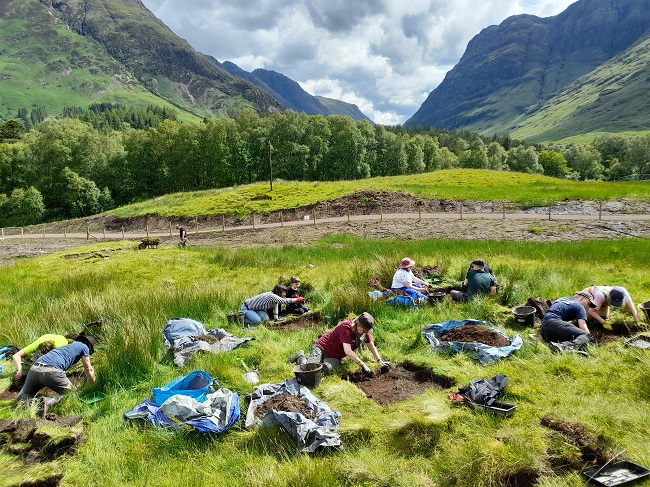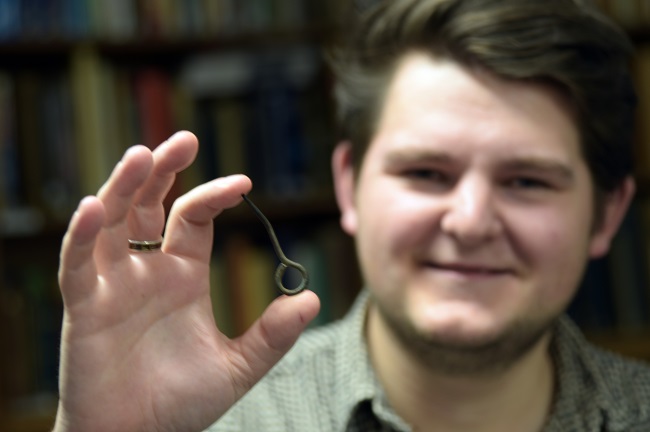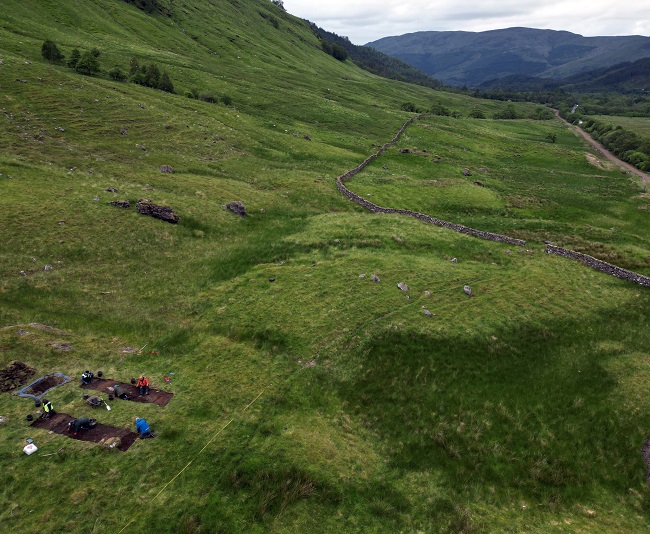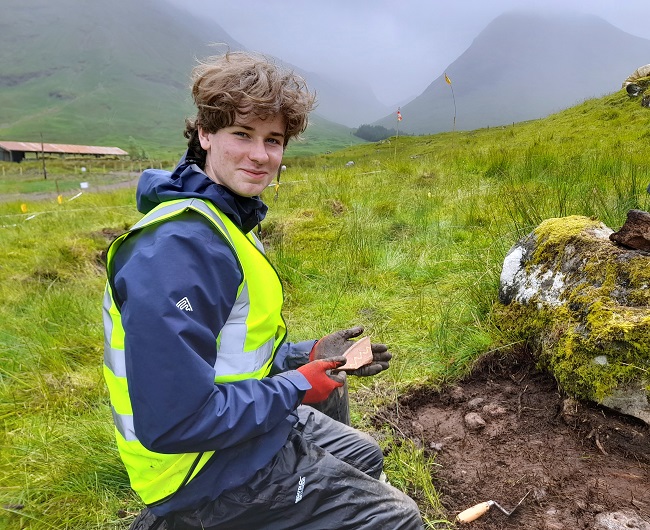Untold stories of Glencoe: archaeology digs reveal poignant artefacts from the past
Published: 13 November 2024
With the support of the National Trust for Scotland, a team of archaeologists and students from the University of Glasgow, along with a variety of volunteers, have spent a second year digging in Glencoe.

Tucked away in the dramatic Highland landscape of Glencoe lies a treasure trove of untold stories, hidden for centuries beneath the earth.
Now, with the support of the National Trust for Scotland, a team of archaeologists and students from the University of Glasgow, along with a variety of volunteers, have spent a second year digging in Glencoe. They aim to grow our understanding of this crucial chapter of Scottish history and the years leading up to the Massacre of Glencoe in 1692.
An estimated 38 members and associates of Clan MacDonald of Glencoe were killed on 13 February 1692, including Clan Chief Alasdair Ruadh “MacIain” MacDonald and his wife.
Through archaeological excavations at the abandoned township of Arhnacon, the researchers have unearthed a wealth of artefacts that provide a rare glimpse into everyday life in 17th century Glencoe, including German and French pottery, decorated knife handles, loom weights for weaving, shoe buckles and broken tobacco pipes.
On the night of the massacre, the MacDonalds of Glencoe Clan Chief’s cousin - the tacksman of Achnacon or MacDonald of Achnacon - was hosting a party with guests including his brother MacDonald of Achtriochtan. They drank and gambled into the early hours, until the party was interrupted at 5am, as a volley of shots from government troops tore through the windows and doors, killing many inside.
The recent archaeological excavations uncovered MacDonald of Achnacon’s turf-walled house and among the finds was a scatter of 17th century bronze coins, potentially the proceeds of the fateful night’s gambling, lost as the massacre began.
MacDonald of Achnacon, unlike his brother, survived and was taken outside to be shot by the government soldiers. However, as they prepared to fire, he tore off his plaid cloak, threw this over his attackers, and fled off into the winter morning darkness. While excavating just outside this house structure, two volunteers on the 2024 dig found a bent plaid pin and two pieces of lead musket balls; the team think these could be the traces of MacDonald of Achnacon’s escape.

Dr Edward Stewart, Excavations Co-Director, who has just finished his PhD at the University of Glasgow, says that these humble artefacts provide a poignant glimpse into the human stories behind these grand historical events. He explained: “By exploring these dwellings and the archaeology of Glencoe, we are able to build a richer understanding, not only of the tragic events of the 1692 Massacre, but also the everyday lives of those who lived and worked in Glencoe in the 17th and 18th centuries.
“Recent discoveries – both in Achnacon this year and the Summerhouse of MacIain in 2023 – allow us to connect with the people who once called this glen ‘home’ in a profoundly personal way. We’re not just uncovering the grand events of history, but the individual human stories that were so painfully disrupted. These help to give intimate insights into the lives and livelihoods, diets, beliefs and experiences of those who lived in this landscape over 300 years ago.”
Alongside the relics found within the ruins of a 17th century dwelling, the team’s landscape surveys have helped to paint a picture of the deep, generations-long relationship between the inhabitants of Achnacon and their environment. This connection to the land only heightens the devastating impact the massacre and subsequent clearances would have had on the local community, say the archaeology team.

Professor Michael Given, Professor of Landscape Archaeology and Co-Director of the University of Glasgow’s archaeological project in Glencoe, said: “It’s abundantly clear that the people of Achnacon were totally dependent on this land. Understanding that relationship allows us to empathise more fully with the trauma they endured when their world was so violently upended.”
According to Derek Alexander, Head of Archaeology at the National Trust for Scotland, the conservation charity who care for the Glencoe National Nature Reserve, the remains of the 17th and 18th century townships in Glencoe are often subtle, with materials potentially recycled for later buildings, dykes and sheepfolds.
Mr Alexander, Excavations Co-Director, added: “The better-preserved historic sites lie further into the glen away from the modern village at the lochside. Achnacon township displays the remains of four or five buildings, a kailyard or small kitchen garden and traces of rig cultivation. It lies within sight of the replica turf house constructed a few years ago at the National Trust for Scotland visitor centre and can be reached along the length of a newly-built walking and cycle track, the Glencoe Greenway. Step by step we are gaining a better understanding of where and how people lived in the glen and enabling visitors today to engage in new ways with the landscape.”
As the Glencoe Archaeology Project continues its work in the years ahead, the team is committed to bringing these lost voices back to life. Through ongoing excavations, landscape studies, and public engagement events, they hope to shed new light on a history that has long been overshadowed by the events of 1692.
Dr Stewart said: “These artefacts may be small and unassuming, but they represent the very real human experiences that unfolded here. The archaeology team feel it is our responsibility to ensure these stories are told, and their legacy is not forgotten.”
In June 2025 excavations will resume at the settlement of Achnacon to uncover more of this township’s lost stories.

The Glencoe Massacre
Alasdair Ruadh “MacIain” MacDonald of Glencoe was chief of the MacDonalds of Glencoe from 1646-1692. The MacDonald Clan of Glencoe took part in the first Jacobite rising of 1689; this resulted in the clan being targeted in the 1692 Massacre of Glencoe. In late January 1692, two companies or approximately 120 men from the Earl of Argyll’s Regiment of Foot arrived in Glencoe from Invergarry and were hosted by the residents of the Glen for two weeks before the grim order was given to ‘put all to the sword under 70’. An estimated 38 members and associates of Clan MacDonald of Glencoe were killed on 13 February 1692, including Maclain and his wife.
Glencoe Excavations
In the summer 2024, excavations were carried out in Glencoe National Nature Reserve. These excavations were a collaboration between the Archaeology Department at the University of Glasgow and the National Trust for Scotland Archaeology Team and involved students from the university developing their archaeological skills through the field school, and a huge team of volunteers from the local community and further afield.
The excavations were co-directed by Dr Edward Stewart and Derek Alexander and supervised by Amy Heller. Survey of the site and the surrounding landscape was directed by Prof Michael Given and supervised by Kaitlyn Whitsitt and Megan Kidd. A programme of digital media and engagement activities was co-directed by Lizzie Robertson, Dr Gareth Beale and Dr Nicole Smith, and supervised by Samantha Bodiam. This project is also supported by the National Trust for Scotland’s Glencoe National Nature Reserve team, and the Glencoe Folk Museum team, as well as a wider team of researchers and specialists.
You can follow the University of Glasgow Glencoe Excavation blog for updates and to hear more about the excavations and surveys the team have worked on: https://glencoeandrannochenvirons.wordpress.com/
You can view a photogrammetric model of the Achnacon excavations here: https://skfb.ly/p8CYU
For more on the 2023 discovery of the Glencoe Hoard and the ‘Summerhouse of MacIain’: https://glencoeandrannochenvirons.wordpress.com/2023/10/09/find-study-coin-hoard/
Glencoe National Nature Reserve
Glencoe National Nature Reserve is in the care of the conservation charity, the National Trust for Scotland. Visit the National Trust for Scotland’s Visitor Centre and reconstruction of a 17th century turf house, to uncover more about this fascinating place and the history of the people who once made their home in this awe-inspiring glen, before Jacobite loyalties and the Clearances saw them replaced with sheep and deer.
For more information, visit Glencoe National Nature Reserve | National Trust for Scotland
About the National Trust for Scotland
Established in 1931, the National Trust for Scotland is Scotland’s largest conservation charity and cares for, shares and speaks up for Scotland’s magnificent heritage. Over the last 90 years the Trust has pioneered public access to and shared ownership of some of the most magnificent buildings, collections and landscapes in Scotland. It cares for more than 100 sites from ancient houses to battlefields, castles, mills, gardens, coastlines, islands, mountain ranges and the plants and animals which depend upon them.
For more information on the National Trust for Scotland visit www.nts.org.uk
History Hit on Glencoe
Produced by History Hit, the award-winning streaming service founded by historian and TV broadcaster Dan Snow, A Scottish Massacre - Unearthing The Secrets of Glencoe explores the recent archaeological discoveries by the University of Glasgow and National Trust for Scotland. The programme premieres on the streaming service on November 14.
First published: 13 November 2024

